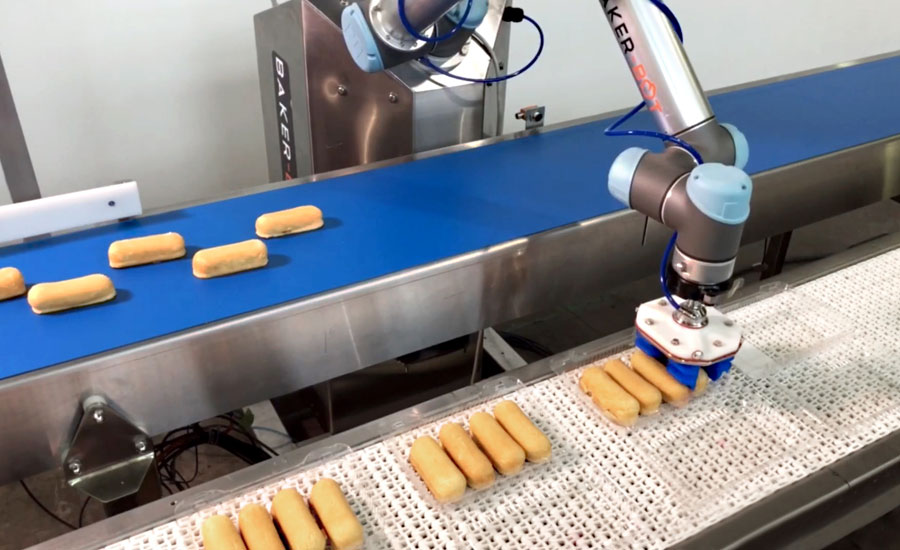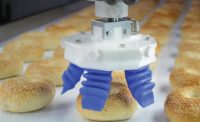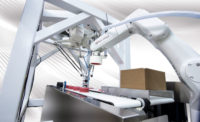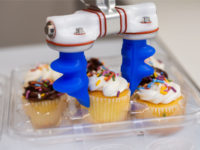Robotics streamlines snack and bakery packaging operations
Advances in EOAT, machine learning, sanitation, and space optimization evolve.

The nature of snack and bakery operations poses challenges to manufacturers of robotics equipment. Space is an issue. Also, the equipment must be able to handle a wide range of products of different shapes and sizes at high speeds while not damaging the goods.
When designing robotics for these environments, two factors are important: speed and footprint, according to John Weddleton, product manager of automation, Harpak-ULMA, Taunton, MA. “Bakery applications require high-speed packaging lines. Products typically exit cooling tunnels, freezers, and de-panning systems in rows that end up equaling hundreds of parts per minute. The challenge is to find a way to pick up several products at once without damaging them.”
Packaging equipment these days needs to be faster, more flexible, and more sustainable—and robotics and automation can help achieve those goals. “In order to satisfy these requirements economically and ecologically as a manufacturer in the packaging process, highly flexible machines and consistently efficient processes are necessary,” says Nadine Hoffmann, marketing manager, Schubert North America, Charlotte, NC.
Another area of innovation includes end-of-arm tooling (EOAT). “There has been a lot of development in making EOAT adaptable to account for different-sized objects. Companies such as Soft Robotics and Festo have developed grippers that adjust on the fly as they pick up items such as cookies and muffins,” says Martin Riis, director of sales and marketing, Apex Motion Control, Vancouver, British Columbia.
Most of the innovation around pick and place robotics lies in EOAT and vision technology, according to Rick Hoskins, president, Colborne Foodbotics, Lake Forest, IL. He sees growing demand for flexible tools that can handle fragile products with wide tolerances. “We have developed hybrid gripping and vacuum tools to handle these kinds of products where one method may not work as efficiently as the two methods combined.”
Joe Curcio, northeast regional sales manager, BluePrint Automation (BPA), South Chesterfield, VA, sees a renewed appreciation for pick and place technology due to its simplicity. “If pick and place can perform the required automation, I find engineers opting for this approach over a more complex 5- or 6-axis robot.” He adds that integrating robotics, pick and place, and traditional mechanical devices, all within the same machine frame, helps reduce floor space requirements over single sourcing any of these technologies.
Robot learning is making advances, as well. For example, the Polymeric AI solution for SuperPick from Soft Robotics, Bedford, MA, features a cloud-based data analytics tool, which provides real-time tracking of process data. This data is used to develop predictive analytics to optimize system performance. “The Polymeric AI can monitor and intervene with the system remotely, from any location,” says Lisa Donnelly, vice president of marketing.
Space-saving designs also are also being developed. More is being done to create denser robotic designs, while still offering a decent working volume, according to Kelly Meer, product manager, Syntegon Packaging Technology, New Richmond, WI. “In the delta robotic area, where we have been building robots for 20 years, we are striving to do just that. We have increased two or three robotic arms per cell to four. It all comes down to arm design and getting them as close as possible without interfering with one another.” Space-saving designs are essential in robotics and will continue to evolve, he adds. “To support higher densities physically, we support more robotic arms with a single controller than we did a few years ago. We now can run one to six delta arms with one controller and a human-machine interface.”
Something new
Schubert offers modular TLM systems, which the company is continuously advancing by developing new robots and digital solutions, says Hoffmann. Up to six of its new four-axis T4 robots can work simultaneously in a single TLM frame. “The T5 variant offers a completely different—and also new—option for machine processes,” she says. “It features a fifth axis with which products can be pivoted and tilted.”
Schubert is also currently working on its first cobot, called tog.519, says Ralf Schubert, managing director and shareholder, Schubert. “The tog.519 robot is designed for pick and place tasks and for separating lightweight products.” A typical task, for example, would be placing pouches in the cartoner’s chain. The tog.519 recognizes the pouches even if they are lying one on top of another, and identifies the chain pitches for placement. The cobot is fast and does not require guard doors, he notes. It slows down when someone gets close to it and stops safely before coming into contact with people.
FANUC America Corp., Rochester Hills, MI, recently introduced two robots that have potential applications in bakery and snack plants. The first is a high-speed delta (picking) robot, the DR-3iB. Its 8-kg payload capacity and large work envelope make it a good match for applications where a wide reach is needed, such as picking products from a conveyor belt. Designed with food safety as a prime consideration, the DR-3iB incorporates angled surfaces, which eliminates particle entrapment points.
The second introduction is the CRX-10iA collaborative robot, which is available in reach variants. “CRX robots incorporate a new easy-to-program operating environment, which allows them to take advantage of the full suite of FANUC integrated vision 2D and 3D products, along with FANUC’s Force Sensing technology,” says Jim Cooper, executive director global accounts, FANUC America.
As part of a strategic relationship with FANUC, Soft Robotics has developed a new controller that is designed for use with any FANUC robot. The mini-P controller works in conjunction with the robot controller and allows the gripper to be programmed and controlled from the robot teach pendant. This enables easy installation of the Soft Robotics mGrip soft gripper onto any FANUC robot.
“The mini-P controller allows actuation gripper speeds of three to four actuations/second, providing the performance needed for high-speed applications while handling delicate bakery items. Soft Robotics also has released a mini finger version of its patented soft gripper fingers, which improves performance related to picking and placement of products,” Donnelly says.
Delta and collaborative robots are widely used within bakery and snack spaces, according to Dean Elkins, segment leader, handling, Yaskawa America Inc., Motoman Robotics Division, Miamisburg, OH. The company has addressed the need for higher sanitation standards with the recent introduction of its HC10XP robot. “This collaborative, Power and Force Limiting (PFL) robot is designed with a 10-kg payload and comes standard with food-grade grease and an IP67 rating, which makes it impervious to the environment during the cleaning process.”
Yaskawa’s collaborative line also includes the HC20XP. Featuring PFL technology, the robot offers a 20-kg payload and 1.7 meters of reach, making it suitable for case packing and palletizing applications. All systems are available with Yaskawa’s Smart Pendant, which simplifies programming tasks.
JLS Automation, York, PA, recently introduced the Osprey Flex vertical/horizontal case packer and the Peregrine cartoning solution. Both machines have hygienic features and a compact footprint, and allow for rapid changeover. The Osprey Flex can handle high-payload foodservice bags, and high-speed loading of retail stand-up pouches. “With the Flex, no tool or vision change is required between SKUs—just a simple recipe change,” says Craig Souser, president and CEO. “The Peregrine utilizes our positive carton transport system to retain full control of the carton from forming through loading, without ever letting go.”
Harpak-ULMA has introduced a system that can automatically feed, load and palletize the reusable plastic containers (RPCs) often used by bakeries. The system can depalletize, destack, open (if RPCs are collapsible) and convey RPCs to the case packing area. “The system can load products into the RPCs before restacking, repalletizing, and stretch-wrapping them for shipment. We also provide automatic washing systems that clean the RPCs and reintroduce them to the packaging lines once they are returned,” Weddleton says.
Stäubli North America, Duncan, SC, recently launched its TS2 SCARA (selective compliance assembly robot arm) series, which can be used in sensitive food environments. The HE version eliminates retention areas by draining fluids alongside its fully enclosed structure. Key compoments are made of stainless steel, and an arm coating withstands full washdown cleaning.
“Stäubli’s technology inside the TS2 HE allows the use of a NSF H1 food-grade oil to safely lubricate each axis without comprising performance. The axes are put in motion by JCS drive technology, which facilitates high-speed motion and high repeatability for ultra-short-cycle times,” says Sebastien Schmitt, manager, Robotics Division, Stäubli North America.
Collaborative robots continue to make an impact. For example, Apex Motion Control offers the Baker-Bot, a collaborative robot that can quickly be moved between production lines. The space-saving unit can work beside people without physical guarding. “We have developed apps that integrate with a bakery’s equipment, such as depositors, extruders, sheeting, and bread lines. Typical applications include moving pans on and off conveyors, liquid depositing and spraying, cake decoration, and packaging,” Riis says.
Fetch Robotics, San Jose, CA, has introduced larger-capacity robots for warehouse environments, as well as software that enables customers to deploy and maintain workflows on their own, without the need for integration. The two large robots carry 1,100 pounds and 3,300 pounds. “Customers are deploying these large robots so they can make their facility safer by confining forklifts to shipping and receiving,” says Steffan Nusser, chief product officer. “Our Workflow Builder software enables production managers to deploy robot workflows in a couple of days.”
Looking ahead
Snack and bakery facilities often pose unique challenges for robotics. “For very creamy or sticky products, it’s always challenging to develop a specific tool that needs less cleaning and maintenance,” says Stefan Hoffmann, sales account manager, Schubert North America. Schubert designers are focusing on optimizing or developing new pick and place tools to address these challenges. The company can work with customers to analyze the behavior of each product at specific speeds to optimize performance.
“With collaborative robotic innovations in the field of easy programming, intelligence, and flexible use at different workplaces, automation will be possible where classic automated systems were limited or not profitable,” predicts Heiko Burkhardt from Schubert-Consulting. Ideally, he suggests, the collaborative robot or human operator can be exchanged depending on the task, and the robot system will be able to learn the new task independently without manual programming.
Elkins predicts that collaborative robots will gain a greater share of applications within the bakery and snack segment due to their easy-to-program and easy-to-deploy nature. “Overall, the combination of easy-to-use robots, vision systems, and innovative grippers will fuel greater and more-effective deployment of robots in this space.”
Meer predicts improvements in 2D and 3D robotics vision, to the point where vision will detect minute cracks and defects in cookies. Vision will be able to see color and determine whether a cookie is under or overcooked. “In effect, vision will become an integral part of quality control.”
Looking for a reprint of this article?
From high-res PDFs to custom plaques, order your copy today!





